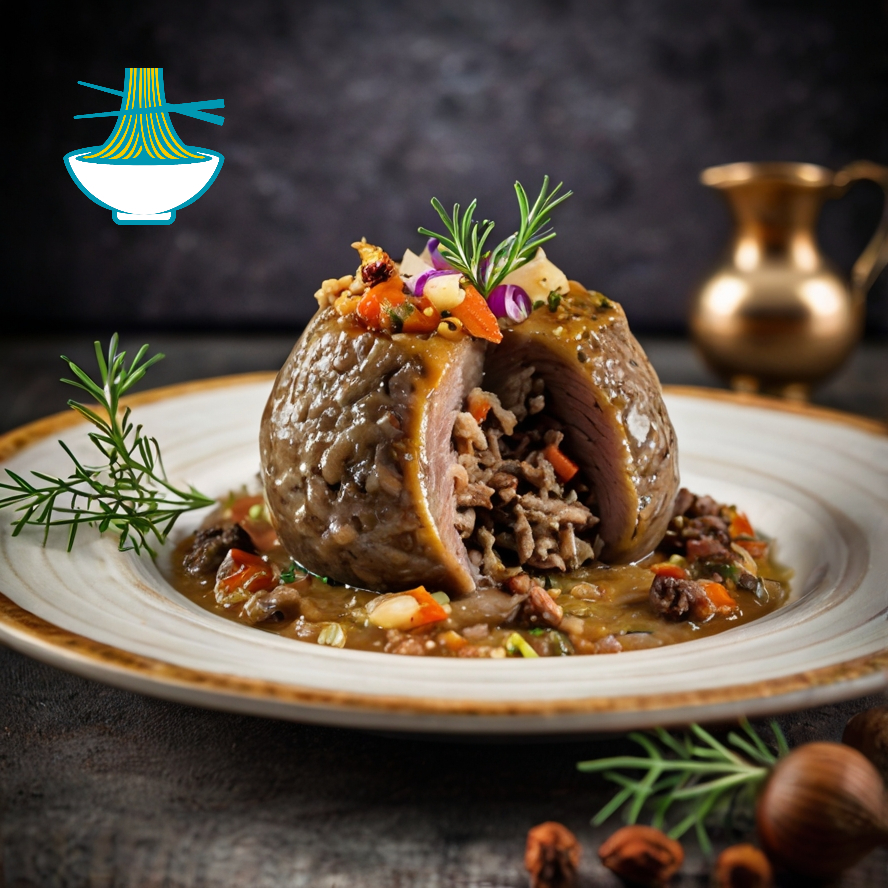Discover the authentic flavor of Scotland with our Traditional Haggis recipe. This savory pudding combines sheep's heart, liver, and lungs with oatmeal, onions, and a blend of spices for a rich, hearty dish. Perfect for a taste of Scottish heritage, our step-by-step guide will help you create this classic comfort food from scratch.
Ingredients:
- 1 sheep's heart
- 1 sheep's liver
- 1 sheep's lung
- 1 cup steel-cut oats
- 1 large onion, finely chopped
- 1/4 cup suet or beef fat
- 1 tsp ground black pepper
- 1 tsp ground coriander
- 1 tsp ground cumin
- 1 tsp ground nutmeg
- 1 tsp dried thyme
- 1/2 cup beef or chicken stock
- Salt, to taste
- 1 large sheep's stomach (for casing, cleaned)
Instructions:
Prepare the Offal:
- Rinse the sheep's heart, liver, and lung thoroughly. Place them in a large pot, cover with water, and simmer for about 2 hours until tender. Drain and let cool.
Grind the Meat:
- Once cooled, finely chop or grind the heart, liver, and lung using a meat grinder or food processor.
Prepare the Oatmeal:
- Toast the steel-cut oats in a dry pan over medium heat until they begin to brown slightly. Set aside.
Cook the Onions:
- In a large skillet, melt the suet or beef fat. Add the finely chopped onions and cook until they are soft and translucent.
Combine Ingredients:
- In a large mixing bowl, combine the ground meat, toasted oats, cooked onions, and spices (black pepper, coriander, cumin, nutmeg, thyme). Mix well.
Add Stock:
- Gradually add the beef or chicken stock to the mixture, stirring until the consistency is moist but not too wet.
Prepare the Casing:
- Rinse the sheep's stomach thoroughly. If necessary, soak it in salted water for a few hours to clean. Stuff the casing with the haggis mixture, packing it tightly. Sew the opening closed with kitchen twine.
Cook the Haggis:
- Place the stuffed casing in a large pot of boiling water. Reduce the heat to a simmer and cook for 3 hours, making sure the water remains at a gentle boil.
Serve:
- Once cooked, remove the haggis from the pot and let it rest for a few minutes before slicing. Serve with traditional sides like neeps (turnips) and tatties (potatoes).
Enjoy this classic Scottish dish with a touch of tradition and rich flavor!
Nutritional values
Sheep's Heart (1)
- Calories: 135 kcal
- Carbohydrates: 0 grams
- Proteins: 22 grams
- Fats: 5 grams
Benefits:
- High in protein and essential nutrients like iron and vitamin B12, which support red blood cell production and overall energy levels.
- Provides omega-3 fatty acids beneficial for heart health.
Sheep's Liver (1)
- Calories: 191 kcal
- Carbohydrates: 4 grams
- Proteins: 30 grams
- Fats: 5 grams
Benefits:
- Extremely rich in vitamins A, B12, and iron, crucial for vision, energy, and blood health.
- High in protein, making it a nutrient-dense food.
Sheep's Lung (1)
- Calories: 85 kcal
- Carbohydrates: 0 grams
- Proteins: 15 grams
- Fats: 2 grams
Benefits:
- Provides high-quality protein and essential vitamins and minerals.
- Lower in fat compared to other organ meats.
Steel-Cut Oats (1 cup)
- Calories: 375 kcal
- Carbohydrates: 67 grams
- Proteins: 12 grams
- Fats: 7 grams
Benefits:
- Excellent source of fiber, which aids in digestion and heart health.
- Contains complex carbohydrates for sustained energy.
Large Onion (1, finely chopped)
- Calories: 40 kcal
- Carbohydrates: 9 grams
- Proteins: 1 gram
- Fats: 0.1 grams
Benefits:
- Adds flavor and contains antioxidants and vitamins.
- May have anti-inflammatory properties.
Suet or Beef Fat (1/4 cup)
- Calories: 891 kcal
- Carbohydrates: 0 grams
- Proteins: 0.5 grams
- Fats: 99 grams (mostly saturated fats)
Benefits:
- Adds richness and moisture to the dish.
- Provides essential fatty acids.
Ground Black Pepper (1 tsp)
- Calories: 255 kcal
- Carbohydrates: 64 grams
- Proteins: 10 grams
- Fats: 3 grams
Benefits:
- Enhances flavor and contains piperine, which may aid digestion.
Ground Coriander (1 tsp)
- Calories: 356 kcal
- Carbohydrates: 75 grams
- Proteins: 6 grams
- Fats: 10 grams
Benefits:
- Adds a warm, citrusy flavor.
- Contains antioxidants and may support digestive health.
Ground Cumin (1 tsp)
- Calories: 375 kcal
- Carbohydrates: 44 grams
- Proteins: 18 grams
- Fats: 15 grams
Benefits:
- Adds a distinct, earthy flavor.
- Contains antioxidants and may aid in digestion.
Ground Nutmeg (1 tsp)
- Calories: 525 kcal
- Carbohydrates: 49 grams
- Proteins: 6 grams
- Fats: 36 grams
Benefits:
- Adds a warm, sweet flavor.
- Contains antioxidants and has potential digestive benefits.
Dried Thyme (1 tsp)
- Calories: 101 kcal
- Carbohydrates: 24 grams
- Proteins: 5 grams
- Fats: 1 gram
Benefits:
- Adds a herby flavor.
- Contains vitamins and antioxidants with antimicrobial properties.
Beef or Chicken Stock (1/2 cup)
- Beef Stock: 15 kcal
- Carbohydrates: 1 gram
- Proteins: 3 grams
- Fats: 0 grams
Benefits:
- Adds flavor and depth to the dish.
- Low in calories and can be rich in minerals depending on preparation.
Salt (to taste)
- Sodium: 38,000 mg
- Calories: 0 kcal
- Carbohydrates, Proteins, Fats: 0 grams
Benefits:
- Enhances flavor and acts as a preservative.
- Important for maintaining electrolyte balance.
Sheep's Stomach (for casing, cleaned)
- Nutritional values are similar to other organ meats, providing protein and some essential nutrients.
Benefits:
- Used as a casing for traditional dishes like haggis.
- Adds an authentic touch to the dish.


Comments